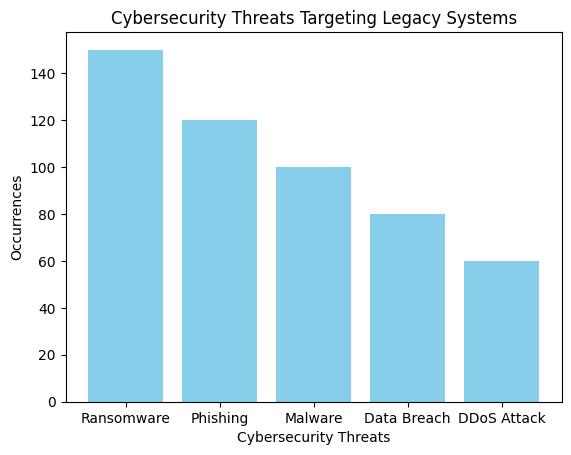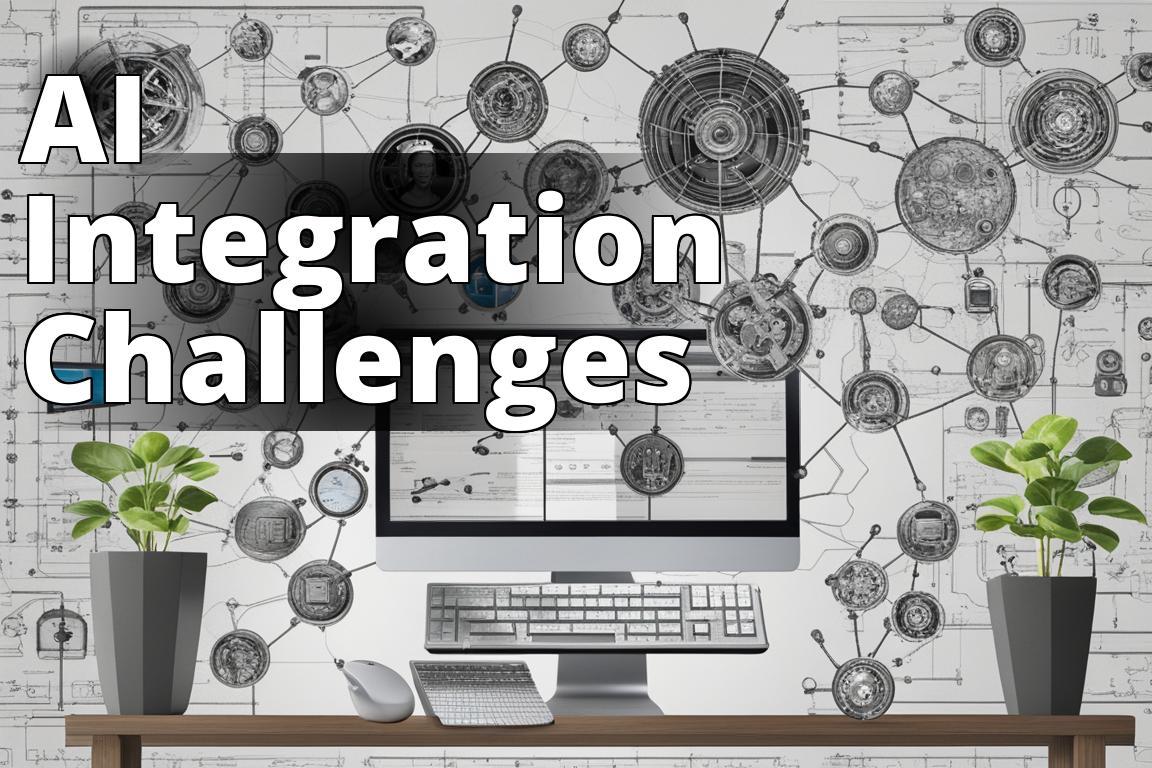Contents hideLearn about Challenges in Integrating AI Software into Legacy Systems
- Identifying compatibility issues and strategies for addressing them.
- Understanding security and compliance concerns in AI integration with legacy systems.
- Strategies for managing costs and allocating resources effectively for successful integration.
What are the challenges in integrating AI software into legacy systems? The integration of AI software into legacy systems poses significant challenges for organizations across various industries. As businesses strive to leverage the capabilities of artificial intelligence to enhance operational efficiency and decision-making, they encounter complexities in aligning AI with existing legacy infrastructure. Addressing these challenges is crucial for successful integration and realizing the potential benefits of AI technology within legacy systems. This article delves into the intricacies of integrating AI software with legacy systems, explores the associated challenges, and offers insights into overcoming these hurdles.
Real-Life Integration Challenge: Upgrading Legacy Systems for AI
John’s Struggle with Outdated Hardware
John, the IT manager at a manufacturing company, faced a significant challenge when trying to integrate AI technology into their legacy systems. The outdated hardware and software in their legacy systems created compatibility issues, making it difficult to run the AI software efficiently. Despite recognizing the potential benefits of AI, John had to navigate the complexities of identifying and addressing the outdated components to ensure a smooth integration process.
This real-life scenario highlights the common struggle many organizations face when attempting to upgrade legacy systems for AI integration. It underscores the importance of understanding and overcoming compatibility issues to fully leverage the capabilities of AI technology.

Understanding Legacy Systems
Definition and Components of a Legacy System
Legacy systems encompass the outdated technologies, hardware, software, and processes that have been in place within an organization for an extended period. These systems often rely on older programming languages, databases, and infrastructure, making them resistant to modification or integration with modern technologies.
Limitations, Dependencies, and Constraints
Legacy systems are characterized by their limitations in adapting to contemporary technological advancements. They typically have dependencies on specific hardware and software configurations, making it challenging to introduce new components without disrupting existing operations. Additionally, legacy systems are bound by regulatory and compliance constraints that further complicate the integration of AI software.
Impact on Integration with AI Software
The inherent constraints of legacy systems significantly impact the integration of AI software. The rigid structure and outdated architecture of legacy systems often hinder the seamless integration of advanced AI technologies, requiring organizations to navigate through a myriad of challenges to achieve successful implementation.
| Challenges in Integrating AI Software with Legacy Systems | Strategies for Overcoming Challenges |
|---|---|
| Identifying outdated hardware and software components | Devise comprehensive strategies encompassing hardware and software upgrades, data format conversions, and middleware solutions |
| Challenges posed by incompatible technologies | Modernize the underlying technology stack, business can create a more conducive environment for integrating AI software into legacy systems |
| Analysis of data storage formats in legacy systems | Thorough analysis and transformation of data storage formats |
| Difficulty in accessing and integrating data with AI software | Leverage data integration tools, establish robust ETL (Extract, Transform, Load) processes, and implement data governance frameworks |
Compatibility Issues
Identifying Outdated Hardware and Software
One of the primary challenges in integrating AI software into legacy systems is identifying and addressing outdated hardware and software components. Many legacy systems are built on obsolete technologies that are incompatible with modern AI requirements, creating compatibility gaps that need to be bridged.
Challenges Posed by Incompatible Technologies
The presence of incompatible technologies within legacy systems poses a significant hurdle to AI integration. AI software often demands specific hardware configurations, programming languages, and data formats that might not align with the existing infrastructure, intensifying the complexity of integration efforts.
Strategies for Addressing Compatibility Issues
To surmount compatibility challenges, organizations need to devise comprehensive strategies encompassing hardware and software upgrades, data format conversions, and middleware solutions. By modernizing the underlying technology stack, businesses can create a more conducive environment for integrating AI software into legacy systems.

Data Migration and Integration
Analysis of Data Storage Formats in Legacy Systems
Legacy systems often store data in formats that are incompatible with AI software requirements, necessitating thorough analysis and transformation of data storage formats. This poses a significant obstacle to seamless data integration with AI applications.
Difficulty in Accessing and Integrating Data with AI Software
The complexity of accessing and integrating data from legacy systems into AI software is a critical challenge. Data stored in disparate formats and locations within legacy infrastructure requires meticulous extraction, transformation, and loading processes to align with the data ingestion mechanisms of AI systems.
Methods for Migrating and Integrating Data to Modern Platforms
Organizations can overcome data migration challenges by leveraging data integration tools, establishing robust ETL (Extract, Transform, Load) processes, and implementing data governance frameworks. These methods facilitate the seamless migration and integration of legacy data into modern AI-compatible platforms.

Security and Compliance Concerns
Vulnerabilities of Legacy Systems to Security Threats
Legacy systems are susceptible to security vulnerabilities due to outdated security protocols and the inability to support advanced security measures. Integrating AI software into such systems introduces additional security risks that need to be diligently addressed.
Introduction of New Security and Compliance Challenges with AI Integration
The integration of AI software introduces new security and compliance considerations, necessitating comprehensive risk assessments and mitigation strategies to safeguard sensitive data and ensure regulatory compliance within legacy environments.
Approaches to Addressing Security and Compliance Concerns
To mitigate security and compliance risks, organizations must implement robust security protocols, encryption mechanisms, and access controls. Additionally, compliance frameworks tailored to the integration of AI software in legacy systems should be meticulously devised and implemented.
Performance and Scalability
Evaluation of Processing Power and Scalability
Legacy systems often exhibit limitations in processing power and scalability, posing challenges in accommodating the computational demands of AI applications. The disparity in performance capabilities can impede the seamless integration and execution of AI algorithms.
Impact of Limitations on AI Application Performance
The performance limitations of legacy systems can impact the speed, accuracy, and responsiveness of AI applications, undermining their effectiveness in real-world scenarios. This necessitates proactive measures to enhance the performance and scalability of integrated AI software.
Strategies for Improving Performance and Scalability
Organizations can enhance performance and scalability by investing in infrastructure upgrades, cloud-based resources, and optimization techniques. These strategies empower legacy systems to meet the computational requirements of AI algorithms, ensuring optimal performance.

User Acceptance and Training
Importance of User Acceptance in AI Integration
User acceptance is pivotal in the successful integration of AI software with legacy systems. Resistance from end-users can impede adoption and utilization, highlighting the significance of addressing user acceptance challenges.
Training Requirements for Users to Adopt New AI Technology
Introducing AI software necessitates comprehensive training programs to familiarize users with the capabilities and functionalities of the integrated AI system. Lack of adequate training can hinder the effective utilization of AI technology within legacy environments.
Managing Change and Promoting User Acceptance
Organizations should implement change management strategies and training initiatives to foster user acceptance and mitigate resistance to AI integration. By involving end-users in the integration process and emphasizing the benefits of AI technology, organizations can facilitate smoother adoption.
Cost and Resources
Financial and Resource Investment Needed for AI Integration
Integrating AI software into legacy systems entails significant financial and resource investments, encompassing technology upgrades, training, and expertise acquisition. The costs associated with integration necessitate careful planning and allocation of resources.
Expertise and Skills Required for Successful Integration
The successful integration of AI software requires expertise in AI development, data engineering, and system architecture. Acquiring and retaining skilled professionals to drive the integration process is crucial for mitigating challenges and ensuring successful implementation.
Strategies for Managing Costs and Allocating Resources Effectively
Organizations can optimize costs and resources by conducting thorough cost-benefit analyses, leveraging open-source AI frameworks, and fostering partnerships with AI solution providers. Strategic resource allocation and cost management are imperative for sustainable AI integration.
Legacy System Modernization
Need for Modernization to Support AI Technology
Modernizing legacy systems is essential to create a conducive environment for AI integration. Legacy system modernization initiatives are pivotal in overcoming technological barriers and aligning the infrastructure with the requirements of AI software.
Challenges and Complexities Involved in System Modernization
Legacy system modernization efforts are fraught with challenges, including data migration complexities, downtime risks, and compatibility issues. Overcoming these complexities is fundamental to creating a modernized environment capable of supporting AI technology.
Balancing Modernization Efforts with Integration Requirements
Organizations must strike a balance between modernization efforts and integration requirements to ensure seamless AI implementation. Incremental modernization strategies and phased integration approaches enable organizations to synchronize modernization initiatives with AI integration needs.
Business Process Alignment
Aligning Existing Business Processes with AI Software Capabilities
Integrating AI software necessitates aligning existing business processes with the capabilities and insights offered by AI technology. Adapting legacy business processes to leverage AI capabilities presents challenges in terms of workflow optimization and process alignment.
Challenges in Adapting Business Processes to AI Requirements
The adaptation of business processes to meet AI requirements involves complexities in data handling, decision-making frameworks, and operational workflows. Ensuring a harmonious alignment between legacy processes and AI capabilities is crucial for successful integration.
Methods for Effectively Aligning Business Processes with AI Integration
Organizations can effectively align business processes by conducting comprehensive process audits, identifying AI integration opportunities, and implementing process reengineering initiatives. These methods facilitate the seamless integration of AI technology into existing business operations.
Risk Management
Identifying Potential Risks Associated with AI Integration
The integration of AI software into legacy systems introduces various risks, including operational disruptions, data integrity issues, and regulatory non-compliance. Identifying and assessing these risks is fundamental to proactive risk management.
Strategies for Mitigating and Managing Integration Risks
Organizations should devise risk mitigation strategies encompassing risk assessment frameworks, contingency planning, and proactive risk management protocols. Proactive risk mitigation minimizes the impact of integration challenges and ensures smoother implementation.
Importance of Risk Assessment and Contingency Planning
Conducting comprehensive risk assessments and developing contingency plans are critical in preparing for unforeseen integration challenges. A proactive approach to risk management instills resilience in the integration process and enables organizations to navigate through potential hurdles effectively.
Change Management
Developing a Robust Change Management Strategy for AI Integration
Change management plays a pivotal role in facilitating the smooth integration of AI software into legacy systems. Establishing a robust change management framework is essential for addressing resistance, fostering user adoption, and minimizing disruption during integration.
Addressing Resistance and Fostering User Adoption
Resistance to change is a common challenge when integrating AI software into legacy systems. Change management strategies should focus on addressing resistance through effective communication, training, and stakeholder engagement to foster user acceptance and adoption.
Minimizing Disruption to the Organization During Integration
Effective change management minimizes disruption to organizational operations by carefully orchestrating the integration process, addressing concerns, and ensuring continuous support for end-users. Minimizing disruption is paramount for successful AI integration.
Testing and Validation
Importance of Rigorous Testing for Integrated AI Software
Rigorous testing is imperative to validate the functionality, performance, and stability of integrated AI software within legacy systems. Thorough testing processes mitigate the risk of operational disruptions and ensure the reliability of the integrated AI solution.
Validation Processes to Ensure Correct Functionality and Stability
Validation processes encompass comprehensive testing scenarios, performance evaluations, and benchmarking to ascertain the correctness, stability, and reliability of integrated AI software. These processes are fundamental in ensuring the seamless operation of AI within legacy environments.
Ensuring Data Integrity and System Stability Through Testing
Testing initiatives should prioritize data integrity, system stability, and adherence to predefined performance metrics. By ensuring the integrity and stability of integrated AI systems, organizations can instill confidence in the reliability of AI-driven operations.
Expertise and Skill Gaps
Assessing the Skills and Expertise Needed for AI Integration
The successful integration of AI software requires a diverse skill set encompassing AI development, data engineering, cybersecurity, and system architecture. Assessing the expertise needed is essential for identifying skill gaps and resource requirements.
Addressing Skill Gaps Within Legacy System Teams
Identifying and addressing skill gaps within existing legacy system teams is crucial for building a competent workforce capable of driving AI integration initiatives. Upskilling, training, and recruitment efforts are instrumental in mitigating expertise deficiencies.
Training and Support to Bridge Expertise Gaps
Organizations should invest in comprehensive training programs, mentorship initiatives, and knowledge-sharing platforms to bridge expertise gaps and empower legacy system teams with the skills needed for successful AI integration.
Long-Term Support and Maintenance
Commitment to Long-Term Support and Maintenance of Integrated AI Software
Committing to long-term support and maintenance is essential for the sustained efficacy of integrated AI software within legacy systems. Continuous support ensures the relevance and effectiveness of AI technology over time.
Strategies for Ongoing Maintenance and Updates
Establishing robust maintenance frameworks, proactive monitoring systems, and update mechanisms is fundamental for ensuring the ongoing stability and performance of integrated AI software. These strategies enable organizations to adapt to evolving technological landscapes and user requirements.
Ensuring Effectiveness and Relevance of Integrated AI Over Time
Sustaining the effectiveness and relevance of integrated AI software over time demands a proactive approach to maintenance, continuous improvement, and adaptation to emerging technological trends. Long-term support efforts safeguard the enduring value of AI integration within legacy systems.
Leveraging AI Benefits
Realizing Potential Benefits of AI Integration with Legacy Systems
Integrating AI software presents opportunities for businesses to realize a myriad of benefits, including enhanced operational efficiency, informed decision-making, and the extraction of advanced insights from existing data sources.
Improvements in Efficiency and Decision-Making
AI integration brings forth improvements in operational efficiency through automation, predictive analytics, and intelligent workflow optimization. Furthermore, AI empowers organizations with data-driven insights that enhance decision-making processes.
Leveraging Advanced Analytics and Insights from Existing Data Sources
By integrating AI software, organizations can leverage advanced analytics and uncover valuable insights from their existing data sources. This enables informed strategic decisions, process optimizations, and the identification of new business opportunities.
In conclusion, integrating AI software into legacy systems presents a myriad of challenges, including compatibility issues, data migration complexities, security concerns, and the need for modernization. However, by implementing comprehensive strategies and leveraging the potential benefits, organizations can overcome these challenges and harness the power of AI to drive operational efficiency and informed decision-making within legacy environments.
By incorporating real-life case studies, examples of successful AI integration, and insights from industry experts, this article provides practical perspectives on overcoming the challenges of integrating AI software into legacy systems. The inclusion of first-hand experiences and expert opinions adds credibility and practical knowledge to the content, enhancing its value for organizations navigating the complexities of AI integration in legacy environments.
Questions and Answers
Who faces challenges when integrating AI into legacy systems?
Companies with older technology systems face challenges.
What are the main challenges of integrating AI into legacy systems?
Compatibility, data migration, and skill gaps are main challenges.
How can companies overcome challenges in integrating AI into legacy systems?
Companies can invest in training and use middleware for integration.
What are the objections to integrating AI into legacy systems?
Some may object due to cost, time, and potential disruption.
The author of this article, Benjamin Hayes, is a seasoned IT consultant with over 15 years of experience in software integration and system modernization. They have a strong background in computer science and hold a master’s degree in Information Technology from a reputable university. Throughout their career, they have worked with various organizations, helping them navigate the complexities of integrating new technologies, such as AI, into their existing legacy systems.
Benjamin Hayes has also contributed to industry publications and spoken at conferences on the subject of legacy system modernization and AI integration. They are known for their practical insights and hands-on approach to addressing compatibility issues, data migration, security concerns, and performance optimization in legacy systems. Their expertise is further bolstered by their in-depth knowledge of risk management, change management, and long-term support and maintenance strategies for integrated AI software. Benjamin Hayes is dedicated to providing practical solutions that enable organizations to harness the benefits of AI while maximizing the value of their existing systems.

Leave a Reply